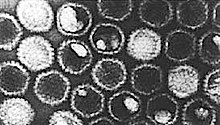Gallid alphaherpesvirus 1 (GaHV-1) is a species of virus in the order Herpesvirales, family Herpesviridae, subfamily Alphaherpesvirinae, and genus Iltovirus.[2] Originally recognised in chickens in the United States in 1926, this virus causes avian infectious laryngotracheitis (abbreviated as AILT, ILT, or LT), a potentially fatal, economically deleterious disease, widely recognised as one of the most contagious diseases in the poultry industry.[3] The virus and its associated disease also occur in pheasants.[which?][4]
| Gallid alphaherpesvirus 1 | |
|---|---|

| |
| Transmission electron micrograph of virions | |
| Virus classification | |
| (unranked): | Virus |
| Realm: | Duplodnaviria |
| Kingdom: | Heunggongvirae |
| Phylum: | Peploviricota |
| Class: | Herviviricetes |
| Order: | Herpesvirales |
| Family: | Orthoherpesviridae |
| Genus: | Iltovirus |
| Species: | Gallid alphaherpesvirus 1
|
| Synonyms | |
| |
| NCBI genome ID | NC_006623 |
|---|---|
| Genome size | 148,687 nucleotides |
| Year of completion | 2005[1] |
Taxonomy
editGallid alphaherpesvirus 1 is classified in the genus Iltovirus. The only other species in this genus, and therefore its closest known relative, is Psittacid alphaherpesvirus 1, which affects parrots.[2]
There are two other herpesviruses that affect chickens: Gallid alphaherpesvirus 2 (cause of Marek's disease) and Gallid alphaherpesvirus 3. Both of these are in a separate genus to Gallid alphaherpesvirus 1; Mardivirus, which is united with Iltovirus under the same subfamily; Alphaherpesvirinae.[2]
Pathology
editTransmission
editGaHV-1 is shed in respiratory secretions and transmitted by droplet inhalation or via fomites. A previously unexposed flock will develop cases for two to eight weeks following introduction. The incubation period is two to eight days.[3]
Clinical signs and diagnosis
editSymptoms include coughing, sneezing, head shaking, lethargy, discharge from the eyes and nostrils (sometimes bloody), and difficulty breathing. The name comes from the severe inflammation of the larynx and trachea. A diphtheritic membrane may form in the trachea, causing obstruction. There may be problems in egg laying and the production of abnormal or thin-shelled eggs. Mortality is typically less than 15 percent.[4]
Histopathology, PCR, ELISA, immunofluorescent staining, and viral isolation are all possible methods of diagnosis.
Treatment and control
editA vaccine is available (ATCvet code: QI01AD08 (WHO)), but it is susceptible to undesired recombination and it does not prevent latent infections. It can be used during an outbreak to decrease morbidity and deaths.
A confirmed case will usually result in the establishment of a quarantine zone around the farm. Inside this quarantine zone, poultry workers will avoid poultry farms to prevent the spread of the virus. Biosecurity measures including quarantine, isolation, and disinfection are very important in controlling the spread of an outbreak.
References
edit- ^ Thureen and Keeler (2005). "Gallid herpesvirus 1, complete genome". National Center for Biotechnology Information. Retrieved 7 January 2019.
- ^ a b c "Virus Taxonomy: 2020 Release". International Committee on Taxonomy of Viruses (ICTV). March 2021. Retrieved 10 May 2021.
- ^ a b Fenner, Frank J.; Gibbs, E. Paul J.; Murphy, Frederick A.; Rott, Rudolph; Studdert, Michael J.; White, David O. (1993). Veterinary Virology (2nd ed.). Academic Press, Inc. ISBN 0-12-253056-X.
- ^ a b Carter, G.R.; Flores, E.F.; Wise, D.J. (2006). "Herpesviridae". A Concise Review of Veterinary Virology. Retrieved 2006-06-10.
Further reading
edit- Coppo, Hartley, Devlin (2013). "Immune responses to infectious laryngotracheitis virus". Developmental and Comparative Immunology. 41 (3): 454–462. doi:10.1016/j.dci.2013.03.022. PMID 23567343.
{{cite journal}}: CS1 maint: multiple names: authors list (link) - Devlin, Browning, Gilkerson (2006). "A glycoprotein I- and glycoprotein E-deficient mutant of infectious laryngotracheitis virus exhibits impaired cell-to-cell spread in cultured cells". Archives of Virology. 151 (7): 1281–1289. doi:10.1007/s00705-005-0721-8. PMID 16502283. S2CID 1699293.
{{cite journal}}: CS1 maint: multiple names: authors list (link) - Devlin, Browning, Hartley, Kikpatrick, Mahmoudian, Noormohammadi, Gilkerson (2006). "Glycoprotein G is a virulence factor in infectious laryngotracheitis virus". Journal of General Virology. 87 (10): 2839–2847. doi:10.1099/vir.0.82194-0. PMID 16963741.
{{cite journal}}: CS1 maint: multiple names: authors list (link) - Loncoman, Hartley, Coppo, Browning, Beltran, Riblet, Freitas, Gracia, Devlin (2018). "Single Nucleotide Polymorphism Genotyping Analysis Shows That Vaccination Can Limit the Number and Diversity of Recombinant Progeny of Infectious Laryngotracheitis Viruses from the United States". Applied and Environmental Microbiology. 84 (23). Bibcode:2018ApEnM..84E1822L. doi:10.1128/AEM.01822-18. PMC 6238068. PMID 30242009.
{{cite journal}}: CS1 maint: multiple names: authors list (link) - Loncoman, Hartley, Coppo, Browning, Quinteros, Diaz-Mendez, Thilakarathne, Fakhri, Vaz, Devlin (2018). "Replication-independent reduction in the number and diversity of recombinant progeny viruses in chickens vaccinated with an attenuated infectious laryngotracheitis vaccine". Vaccine. 36 (38): 5709–5716. doi:10.1016/j.vaccine.2018.08.012. PMID 30104116. S2CID 51972915.
{{cite journal}}: CS1 maint: multiple names: authors list (link) - Loncoman, Hartley, Coppo, Vaz, Diaz-Mendez, Browning, Garcia, Spatz, Devlin (2017). "Genetic Diversity of Infectious Laryngotracheitis Virus during In Vivo Coinfection Parallels Viral Replication and Arises from Recombination Hot Spots within the Genome". Applied and Environmental Microbiology. 83 (23). Bibcode:2017ApEnM..83E1532L. doi:10.1128/AEM.01532-17. PMC 5691407. PMID 28939604.
{{cite journal}}: CS1 maint: multiple names: authors list (link) - Loncoman, Hartley, Coppo, Vaz, Diaz-Mendez, Browning, Lee, Devlin (2017). "Development and application of a TaqMan single nucleotide polymorphism genotyping assay to study infectious laryngotracheitis virus recombination in the natural host". PLOS ONE. 12 (3): e0174590. Bibcode:2017PLoSO..1274590L. doi:10.1371/journal.pone.0174590. PMC 5370143. PMID 28350819.
{{cite journal}}: CS1 maint: multiple names: authors list (link) - Morales Ruiz, Bendezu Eguis, Montesinos, Tataje-Lavanda, Fernandez-Diaz (2018). "Full-Genome Sequence of Infectious Laryngotracheitis Virus (Gallid Alphaherpesvirus 1) Strain VFAR-043, Isolated in Peru". Microbiology Resource Announcements. 6 (10). doi:10.1128/genomeA.00078-18. PMC 5843735. PMID 29519822.
{{cite journal}}: CS1 maint: multiple names: authors list (link)
External links
edit- Avian infectious laryngotracheitis, expert reviewed and published by WikiVet, accessed 07/10/2011
- Virus Pathogen Database and Analysis Resource (ViPR): Herpesviridae